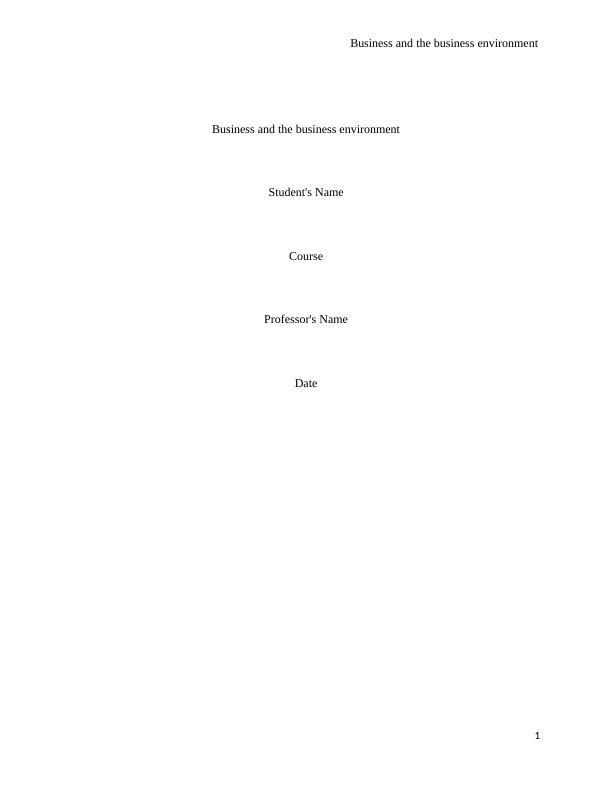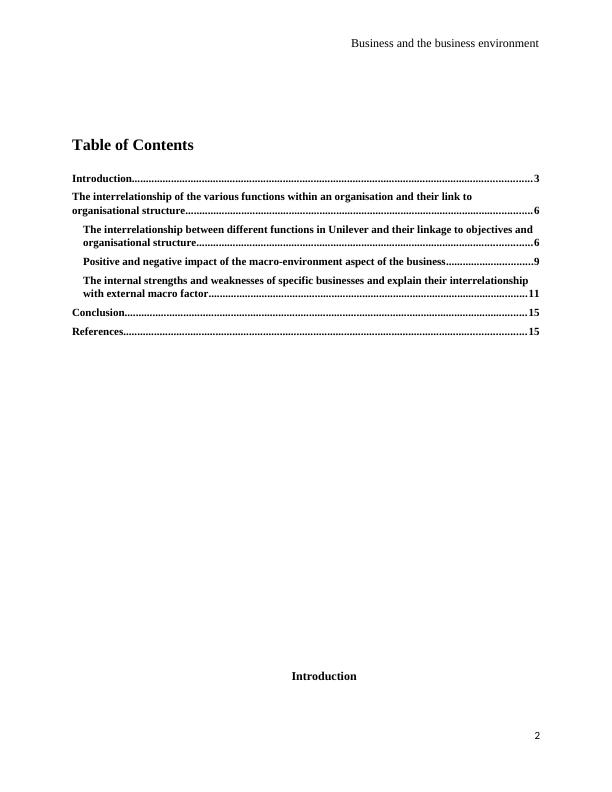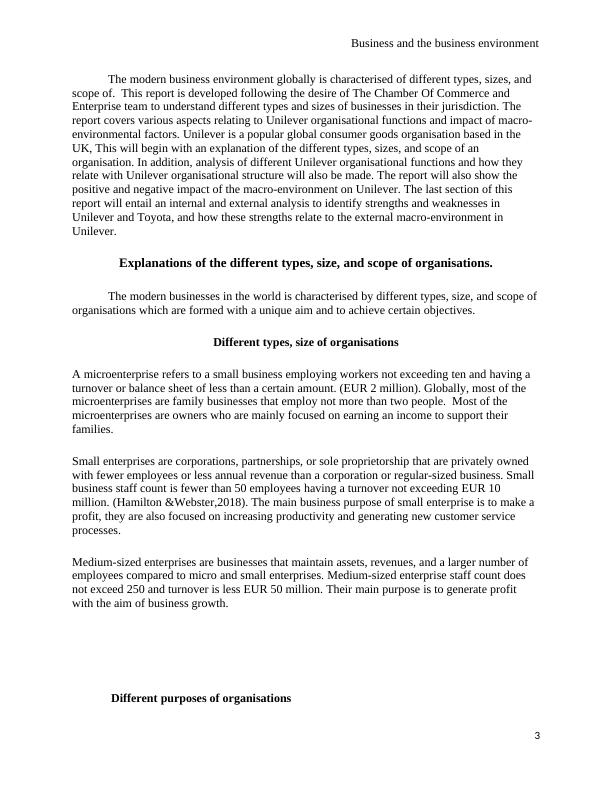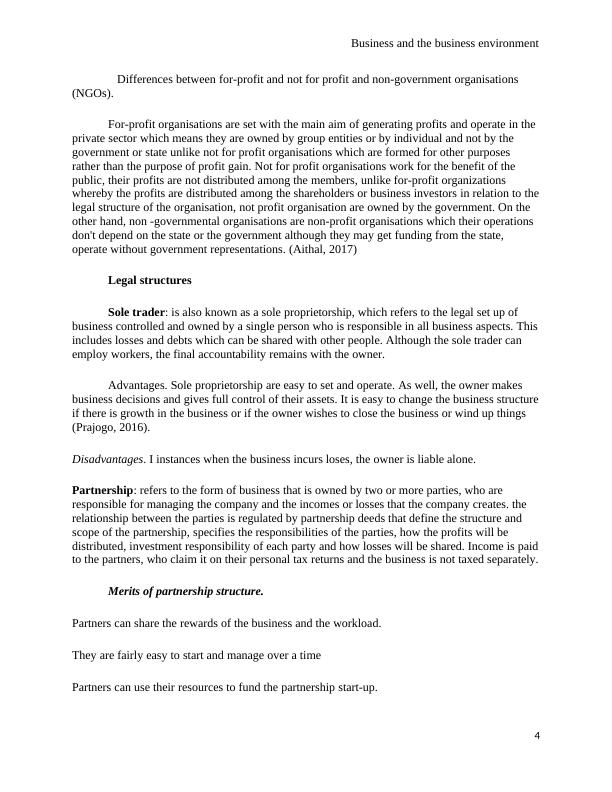Business Environment Assignment : Unilever
17 Pages5535 Words138 Views
Added on 2021-05-25
Business Environment Assignment : Unilever
Added on 2021-05-25
ShareRelated Documents
Business and the business environmentBusiness and the business environmentStudent's NameCourseProfessor's NameDate1

Business and the business environmentTable of ContentsIntroduction...............................................................................................................................................3The interrelationship of the various functions within an organisation and their link to organisational structure............................................................................................................................6The interrelationship between different functions in Unilever and their linkage to objectives and organisational structure........................................................................................................................6Positive and negative impact of the macro-environment aspect of the business...............................9The internal strengths and weaknesses of specific businesses and explain their interrelationship with external macro factor..................................................................................................................11Conclusion................................................................................................................................................15References................................................................................................................................................15Introduction2

Business and the business environmentThe modern business environment globally is characterised of different types, sizes, and scope of. This report is developed following the desire of The Chamber Of Commerce and Enterprise team to understand different types and sizes of businesses in their jurisdiction. The report covers various aspects relating to Unilever organisational functions and impact of macro-environmental factors. Unilever is a popular global consumer goods organisation based in the UK, This will begin with an explanation of the different types, sizes, and scope of an organisation. In addition, analysis of different Unilever organisational functions and how they relate with Unilever organisational structure will also be made. The report will also show the positive and negative impact of the macro-environment on Unilever. The last section of this report will entail an internal and external analysis to identify strengths and weaknesses in Unilever and Toyota, and how these strengths relate to the external macro-environment in Unilever.Explanations of the different types, size, and scope of organisations.The modern businesses in the world is characterised by different types, size, and scope oforganisations which are formed with a unique aim and to achieve certain objectives.Different types, size of organisationsA microenterprise refers to a small business employing workers not exceeding ten and having a turnover or balance sheet of less than a certain amount. (EUR 2 million). Globally, most of the microenterprises are family businesses that employ not more than two people. Most of the microenterprises are owners who are mainly focused on earning an income to support their families.Small enterprises are corporations, partnerships, or sole proprietorship that are privately owned with fewer employees or less annual revenue than a corporation or regular-sized business. Small business staff count is fewer than 50 employees having a turnover not exceeding EUR 10 million. (Hamilton &Webster,2018). The main business purpose of small enterprise is to make a profit, they are also focused on increasing productivity and generating new customer service processes.Medium-sized enterprises are businesses that maintain assets, revenues, and a larger number of employees compared to micro and small enterprises. Medium-sized enterprise staff count does not exceed 250 and turnover is less EUR 50 million. Their main purpose is to generate profit with the aim of business growth.Different purposes of organisations3

Business and the business environment Differences between for-profit and not for profit and non-government organisations (NGOs). For-profit organisations are set with the main aim of generating profits and operate in the private sector which means they are owned by group entities or by individual and not by the government or state unlike not for profit organisations which are formed for other purposes rather than the purpose of profit gain. Not for profit organisations work for the benefit of the public, their profits are not distributed among the members, unlike for-profit organizations whereby the profits are distributed among the shareholders or business investors in relation to thelegal structure of the organisation, not profit organisation are owned by the government. On the other hand, non -governmental organisations are non-profit organisations which their operations don't depend on the state or the government although they may get funding from the state, operate without government representations. (Aithal, 2017)Legal structures Sole trader: is also known as a sole proprietorship, which refers to the legal set up of business controlled and owned by a single person who is responsible in all business aspects. Thisincludes losses and debts which can be shared with other people. Although the sole trader can employ workers, the final accountability remains with the owner.Advantages. Sole proprietorship are easy to set and operate. As well, the owner makes business decisions and gives full control of their assets. It is easy to change the business structureif there is growth in the business or if the owner wishes to close the business or wind up things (Prajogo, 2016).Disadvantages. I instances when the business incurs loses, the owner is liable alone. Partnership: refers to the form of business that is owned by two or more parties, who are responsible for managing the company and the incomes or losses that the company creates. the relationship between the parties is regulated by partnership deeds that define the structure and scope of the partnership, specifies the responsibilities of the parties, how the profits will be distributed, investment responsibility of each party and how losses will be shared. Income is paidto the partners, who claim it on their personal tax returns and the business is not taxed separately.Merits of partnership structure.Partners can share the rewards of the business and the workload.They are fairly easy to start and manage over a timePartners can use their resources to fund the partnership start-up.4

End of preview
Want to access all the pages? Upload your documents or become a member.
Related Documents
BUSINESS AND BUSINESS ENVIRONMENT UNIT 1: BUSINESS AND BUSINESS ENVIRONMENTlg...
|14
|5898
|75
Business and Business Environmentlg...
|2
|1976
|189
Types of Business Organizations on the Basis of Size, Scope, and Organizational Structurelg...
|11
|2541
|166
Different Types of Companies and Business Structureslg...
|10
|2771
|47
Different Types, Size and Scope of Organisationslg...
|17
|4118
|27
Different Types of Companies and Organizational Structureslg...
|12
|2497
|66
